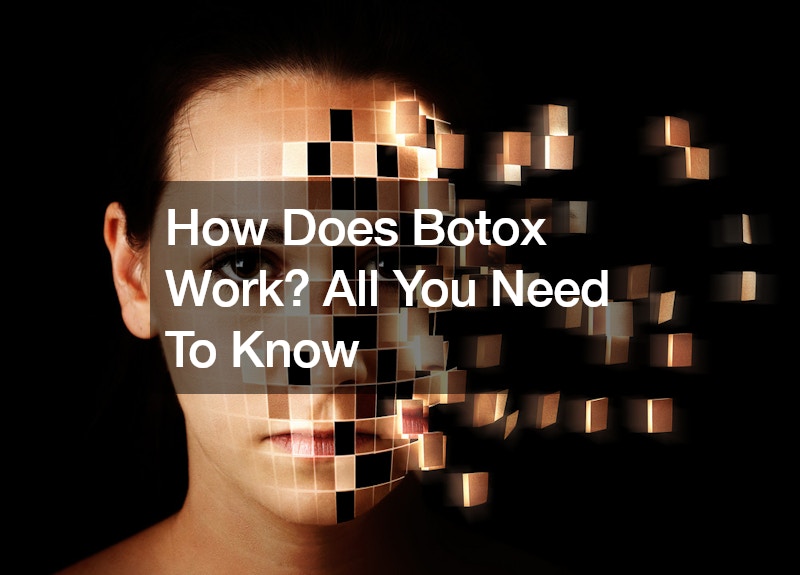Botox has become a household name in the realm of cosmetic procedures, hailed for its ability to smooth wrinkles and rejuvenate the skin. But how exactly does Botox work its magic? In this comprehensive guide, we delve into the science behind Botox, exploring its mechanism of action, applications, and potential benefits.
Understanding Wrinkle Formation:
Before talking about how Botox works, it’s essential to understand how wrinkles form. When facial muscles contract during expressions like smiling or frowning, a cascade of neurotransmitter reactions is triggered. This process involves the fusion of synaptic vesicles with the plasma membrane and the activation of snare proteins in the nerve terminal.
Ultimately, this leads to muscle contraction and the formation of wrinkles in the overlying skin.
The Role of Botulinum Toxin (Botox):
Botulinum toxin, more commonly referred to as Botox, is a potent neurotoxic protein originating from the bacterium Clostridium botulinum. Comprising both a light and heavy chain, this complex molecule holds significant importance in the realm of cosmetic and medical treatments. Once administered into the skin, Botox specifically targets synaptic vesicles housed within nerve terminals, initiating a cascade of intricate biochemical processes. These processes lead to the temporary inhibition of neurotransmitter release, particularly acetylcholine, which is responsible for muscle contraction. By interfering with this neurotransmitter pathway, Botox effectively blocks the communication between nerves and muscles, resulting in muscle paralysis. This mechanism lies at the core of Botox’s ability to alleviate dynamic wrinkles caused by repetitive facial movements. As a result, Botox has become a cornerstone in the field of aesthetic medicine, offering individuals a reliable and minimally invasive solution for combating the visible signs of aging.
How Botox Works:
Once inside the synaptic vesicles, the light chain of Botox undergoes a process where it separates from the plasma membrane. Once liberated, it proceeds to deactivate snare proteins, crucial components responsible for initiating muscle contraction. Through this intricate mechanism, Botox effectively induces paralysis in the facial muscles, thereby impeding their ability to contract and consequently preventing the formation of wrinkles. This temporary state of muscle relaxation typically persists for several months before gradually diminishing, allowing natural muscle function to resume.
Applications of Botox:
Botox is most commonly used to reduce the appearance of dynamic wrinkles, which are caused by repetitive muscle movements. It is particularly effective in smoothing frown lines, crow’s feet, and forehead wrinkles. Additionally, Botox can be used for medical purposes, such as treating migraines, excessive sweating (hyperhidrosis), and muscle spasms.
A New Trend Is Here
One emerging trend in the field of cosmetic dermatology is preventative Botox, which involves using Botox injections at an earlier age to prevent the formation of wrinkles. By targeting specific facial muscles before wrinkles become deeply etched, preventative Botox can help individuals maintain a youthful appearance and delay the onset of aging signs.
Benefits of Botox:
Besides its wrinkle-smoothing effects, Botox offers several benefits for individuals seeking facial rejuvenation. These include:
- Non-surgical: Botox is a minimally invasive procedure that requires no downtime, making it an attractive option for those with busy lifestyles.
- Quick Results: Patients typically notice improvements within a few days of treatment, with optimal results appearing within 1-2 weeks.
- Customizable: Botox treatments can be tailored to each individual’s unique aesthetic goals, ensuring natural-looking results.
- Long-lasting: While the effects of Botox are temporary, they can last for several months, providing patients with lasting benefits.
Side Effects and Considerations:
Although Botox is considered safe when administered by a qualified healthcare professional, it may cause temporary side effects such as bruising, swelling, or mild discomfort at the injection site. Rarely, more serious complications such as drooping eyelids or difficulty swallowing may occur, but these are typically temporary and resolve on their own.
Conclusion:
In conclusion, Botox stands as a versatile and effective cosmetic treatment renowned for its ability to combat the visible signs of aging. By temporarily paralyzing facial muscles, Botox diminishes the appearance of wrinkles, particularly those formed by repetitive muscle contractions. This mechanism of action, which disrupts the neurotransmitter cascade responsible for muscle contraction, underscores the efficacy of Botox in addressing dynamic wrinkles. Moreover, Botox offers several advantages, including minimal downtime and personalized treatment plans tailored to each individual’s aesthetic goals. Its quick results and long-lasting effects further contribute to its widespread popularity among patients seeking facial rejuvenation. With Botox, individuals can achieve smoother, more youthful-looking skin without the need for invasive surgical procedures. As a non-surgical option, Botox provides a convenient and accessible solution for those looking to restore confidence and vitality to their appearance. Overall, Botox continues to be a trusted choice for individuals seeking safe, effective, and customizable anti-aging treatments.
.


